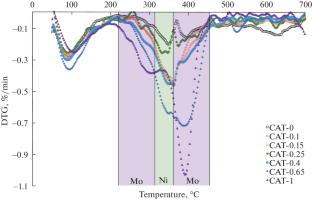Mo/(Ni + Mo)比对Ni - Mo/ZSM-23催化剂加氢处理脂肪酸混合物活性和选择性的影响
IF 1.3
Q4 ENGINEERING, CHEMICAL
引用次数: 0
摘要
以Ni/ZSM-23为基材,合成了一套初始Ni含量为5wt %的Ni - mo双金属催化剂。在温度为300℃,压力为2.5 MPa, WHSV = 8.4 h−1的流动反应器中对脂肪酸混合物(C16-C18)进行了加氢处理试验。研究了金属比对脂肪酸加氢处理催化剂的活性、异烷烃选择性和稳定性的影响。在Mo/(Ni + Mo)比为0.25的催化剂存在下,脱氧能力和异烷烃产率最高,其中,根据XPS,表面Mo/(Ni + Mo)比为0.4。本文章由计算机程序翻译,如有差异,请以英文原文为准。

Effect of Mo/(Ni + Mo) Ratio on the Activity and Selectivity of Ni–Mo/ZSM-23 Catalysts in the Hydrotreating of a Fatty Acid Mixture
A set of Ni–Mo bimetallic catalysts based on Ni/ZSM-23 with an initial Ni content of 5 wt % has been synthesized. The catalysts have been tested in the hydrotreating of a mixture of fatty acids (C16–C18) in a flow reactor at a temperature of 300°C, a pressure of 2.5 MPa, and WHSV = 8.4 h−1. The effect of the metal ratio on the activity, isoalkane selectivity, and stability of the catalysts in the hydrotreating of a fatty acid mixture has been shown. The highest deoxygenating capacity and the highest isoalkane yield have been found in the presence of a catalyst with a Mo/(Ni + Mo) ratio of 0.25, in which, according to XPS, the Mo/(Ni + Mo) ratio on the surface is 0.4.
求助全文
通过发布文献求助,成功后即可免费获取论文全文。
去求助
来源期刊

Catalysis in Industry
ENGINEERING, CHEMICAL-
CiteScore
1.30
自引率
14.30%
发文量
21
期刊介绍:
The journal covers the following topical areas:
Analysis of specific industrial catalytic processes: Production and use of catalysts in branches of industry: chemical, petrochemical, oil-refining, pharmaceutical, organic synthesis, fuel-energetic industries, environment protection, biocatalysis; technology of industrial catalytic processes (generalization of practical experience, improvements, and modernization); technology of catalysts production, raw materials and equipment; control of catalysts quality; starting, reduction, passivation, discharge, storage of catalysts; catalytic reactors.Theoretical foundations of industrial catalysis and technologies: Research, studies, and concepts : search for and development of new catalysts and new types of supports, formation of active components, and mechanochemistry in catalysis; comprehensive studies of work-out catalysts and analysis of deactivation mechanisms; studies of the catalytic process at different scale levels (laboratory, pilot plant, industrial); kinetics of industrial and newly developed catalytic processes and development of kinetic models; nonlinear dynamics and nonlinear phenomena in catalysis: multiplicity of stationary states, stepwise changes in regimes, etc. Advances in catalysis: Catalysis and gas chemistry; catalysis and new energy technologies; biocatalysis; nanocatalysis; catalysis and new construction materials.History of the development of industrial catalysis.
 求助内容:
求助内容: 应助结果提醒方式:
应助结果提醒方式:


